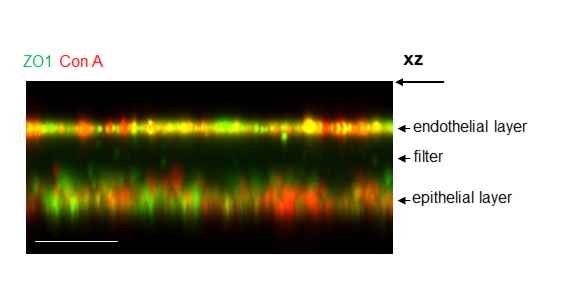Sie befinden sich hier
Inhalt

The human brain contains specific barriers that separate the central nervous system from the reminder of the body. This barriers include the blood-brain barrier at the brain microvasculature and a blood-cerebrospinal fluid barrier located at the choroid plexus in the ventricular system. Both barriers contain endothelial structures. At the blood-brain barrier the main barrier component are the brain microvascular endothelial cells, which are supported by astrocytes and pericytes. In contrast, at the blood-cerebrospinal fluid barrier the morphological correlate of the barrier is the choroid plexus epithelium, whereas the endothelium is fenestrated. Still, recent data have shown that inflammatory events can lead to closing of a choroid plexus vascular barrier.
The blood-brain barrier and the blood-cerebrospinal fluid barrier are targeted during central nervous system infection for the entry of pathogens into the brain. It is a main focus of our laboratory to investigate the interactions between pathogens and the endothelia at these barriers, including the role of virulence factors, host cell responses, and the interplay of endothelial cells with other barrier components (e.g. epithelial cells).
Central research questions
- Establishment of a two-cell type model of the blood-cerebrospinal fluid barrier consisting of CP epithelial and endothelial cells.
- Interactions of pathogens (bacterial, viral, other) with the endothelium of the blood-brain barrier and the blood-cerebrospinal fluid barrier.
Research projects
DFG: “Signal transduction during central nervous system invasion by Listeria monocytogenes – the role of host cell factors with a focus on CD44”. Research project in collaboration with Prof. Dr. Orian Rousseau, Karlsruher Institute of Technology (KIT). Project duration: 2017 – 2020

Selected publications
- The role of PLVAP in endothelial cells.
Denzer L, Muranyi W, Schroten H, Schwerk C. Cell Tissue Res. 2023. 392(2):393-412. doi: 10.1007/s00441-023-03741-1. - Immortalized human choroid plexus endothelial cells enable an advanced endothelial-epithelial two-cell type in vitro model of the choroid plexus.
Muranyi W, Schwerk C, Herold R, Stump-Guthier C, Lampe M, Fallier-Becker P, Weiß C, Sticht C, Ishikawa H, Schroten H. iScience. 2022. 25(6):104383. doi: 10.1016/j.isci.2022.104383. - Different Involvement of Vimentin during Invasion by Listeria monocytogenes at the Blood-Brain and the Blood-Cerebrospinal Fluid Barriers In Vitro.
Banovic F, Schulze S, Abu Mraheil M, Hain T, Chakraborty T, Orian-Rousseau V, Moroniak S, Weiss C, Ishikawa H, Schroten H, Adam R, Schwerk C. Int J Mol Sci. 2022. 23(21):12908. doi: 10.3390/ijms232112908. - Immortalized human choroid plexus endothelial cells enable an advanced endothelial-epithelial two-cell type in vitro model of the choroid plexus.
Muranyi W, Schwerk C, Herold R, Stump-Guthier C, Lampe M, Fallier-Becker P, Weiß C, Sticht C, Ishikawa H, Schroten H. iScience. 2022. 25(6):104383. doi: 10.1016/j.isci.2022.104383. - Cross-sectional seroprevalence surveys of SARS-CoV-2 antibodies in children in Germany, June 2020 to May 2021.
Sorg AL, Bergfeld L, Jank M, Corman V, Semmler I, Goertz A, Beyerlein A, Verjans E, Wagner N, Von Bernuth H, Lander F, Weil K, Hufnagel M, Spiekerkoetter U, Chao CM, Naehrlich L, Muntau AC, Schulze-Sturm U, Hansen G, Wetzke M, Jung AM, Niehues T, Fricke-Otto S, Von Both U, Huebner J, Behrends U, Liese JG, Schwerk C, Drosten C, Von Kries R, Schroten H. Nat Commun. 2022. 13(1):3128. doi: 10.1038/s41467-022-30482-6. - Potential Roles and Functions of Listerial Virulence Factors during Brain Entry.
Banović F, Schroten H, Schwerk C. Toxins (Basel). 2020. 12(5):297. doi: 10.3390/toxins12050297. - Virulence Factors of Meningitis-Causing Bacteria: Enabling Brain Entry across the Blood-Brain Barrier
Herold R, Schroten H, Schwerk C. Int J Mol Sci. 2019. 20(21):5393. doi: 10.3390/ijms20215393. - The diverse cellular responses of the choroid plexus during infection of the central nervous system.
Lauer AN, Tenenbaum T, Schroten H, Schwerk C. Am J Physiol Cell Physiol. 2018. 314(2):C152-C165. doi: 10.1152/ajpcell.00137.2017. - The choroid plexus-a multi-role player during infectious diseases of the CNS.
Schwerk C, Tenenbaum T, Kim KS, Schroten H. Front Cell Neurosci. 2015. 9:80. doi: 10.3389/fncel.2015.00080. eCollection 2015. - A single nucleotide polymorphism determines protein isoform production of the human c-FLIP protein
Ueffing N, Singh KK, Christians A, Thorns C, Feller AC, Nagl F, Fend F, Heikaus S, Marx A, Zotz RB, Brade J, Schulz WA, Schulze-Osthoff K, Schmitz I, Schwerk C. Blood. 2009. 114(3):572-9. doi: 10.1182/blood-2009-02-204230.
Kontextspalte
Contact
Medical Faculty Mannheim
Heidelberg University
Theodor-Kutzer-Ufer 1-3
68167 Mannheim
